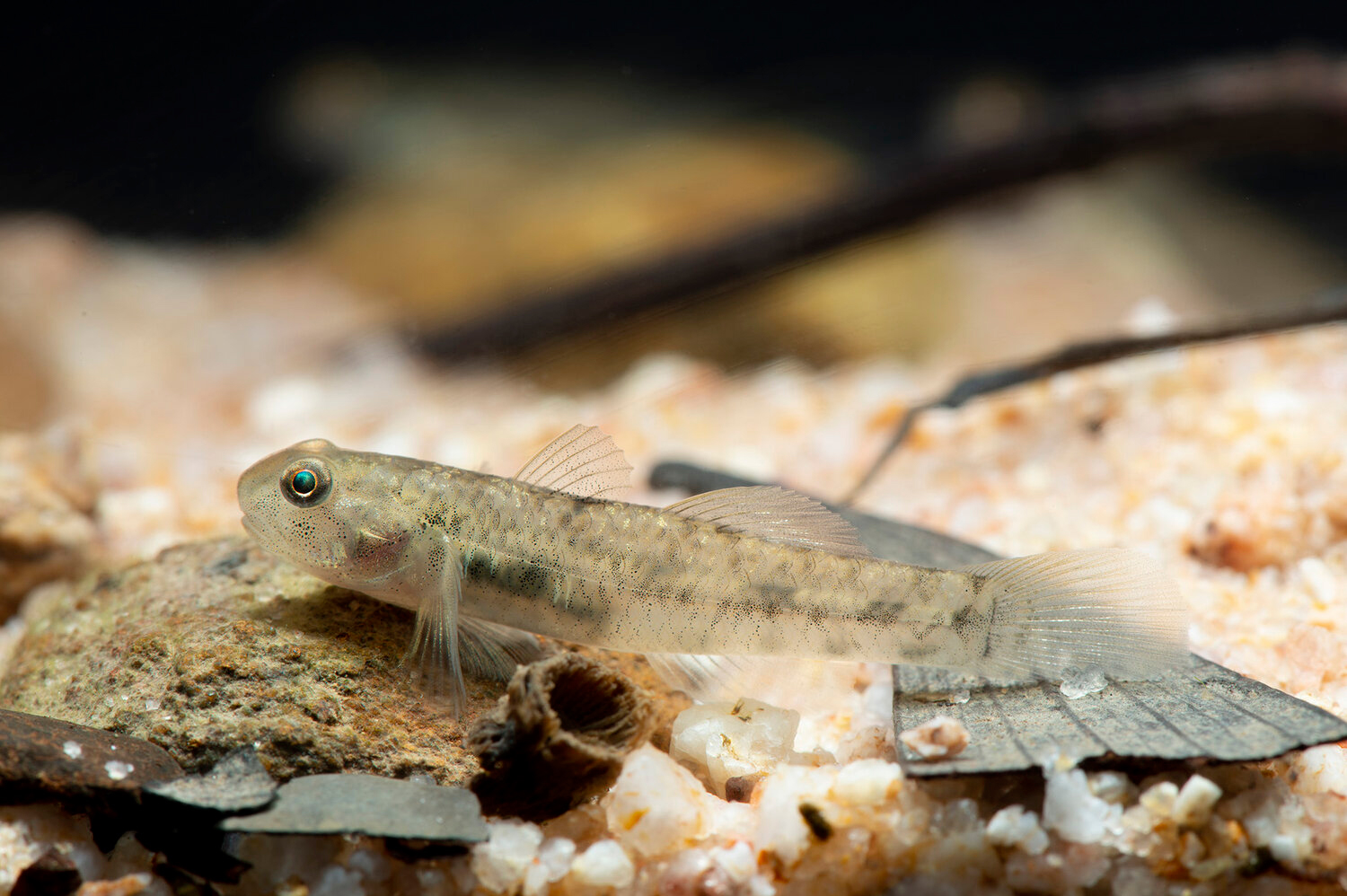- Classification
- ACTINOPTERYGII
- PERCIFORMES
- GOBIIDAE
- Pseudogobius
- aquilonius
Northern Snubnose Goby, Pseudogobius aquilonius Larson & Hammer 2021

A male Northern Snubnose Goby, Pseudogobius aquilonius, from a tributary of Chinaman Creek, Cairns, Queensland. Source: Michael Hammer / Northern Territory Museum. License: All rights reserved
Summary:
A small goby with brown scale margins, about 5–6 small elongate brown blotches along the mid-side, with the rear blotch on the rear of the caudal peduncle extending onto the caudal fin and coalescing with a narrow vertical dark bar on the fin base.
Cite this page as:
Bray, D.J. 2022, Pseudogobius aquilonius in Fishes of Australia, accessed 27 Jun 2025, https://fishesofaustralia.net.au/Home/species/5587
Northern Snubnose Goby, Pseudogobius aquilonius Larson & Hammer 2021
More Info
|
Distribution |
Endemic to northern Australia, from Dampier, Western Australia, to Brisbane, Queensland. Occurs in shallow-water estuarine habitats, including tidal rivers, mangrove creeks and muddy tide-pools, at depths to one metre, with substrates of sandy mud, mud and mangrove roots, logs and leaf litter. |
|
Features |
Dorsal fin VI + I,6–8; Anal fin I,6–7; Pectoral fin 14–17; segmented caudal rays 15–16, in 9/7 pattern; lateral scales 24–27; TRB 7–9; predorsal scales 6–8; opercle with at least 2 rows of cycloid scales, rarely with a cycloid scale on cheek right behind eye; shoulder girdle smooth or with narrow bony flange; tongue short and may be greatly reduced; in males, teeth in outer row of upper jaw slightly flattened, blunt-tipped or pointed, with two curved symphyseal canines behind anterior tooth rows, while in females, outer row teeth of upper jaw small, compressed and blunt-tipped. |
|
Etymology |
The specific name is from the Latin aquilonius (= north, northerly), in reference to this Australian species’ distribution around the north coast of the country. |
|
Species Citation |
Pseudogobius aquilonius Larson & Hammer 2021, Zootaxa 4961(1): 10, Figs 4-5. Type locality: east arm of Bing Bong Creek, Gulf of Carpentaria, Northern Territory. |
|
Author |
Bray, D.J. 2022 |
|
Resources |
Northern Snubnose Goby, Pseudogobius aquilonius Larson & Hammer 2021
References
Blaber, S.J.M., Brewer, D.T. & Salini, J.P. 1992. A checklist of the fishes of Groote Eylandt, north-western Gulf of Carpentaria. CSIRO Marine Laboratories Report 218: 1–12 (as Pseudogobius sp.)
Davis, T.L.O. 1988. Temporal changes in the fish fauna entering a tidal swamp system in tropical Australia. Environmental Biology of Fishes 21(3): 161–172. https://doi.org/10.1007/BF00004860 (as Pseudogobius sp.)
Hammer, M.P., Adams, M., Unmack, P.J., Hassell, K.L. & Bertozzi, T. 2021. Surprising Pseudogobius: molecular systematics of benthic gobies reveals new insights into estuarine biodiversity (Teleostei: Gobiiformes). Molecular Phylogenetics and Evolution 160: (e107140), https://doi.org/10.1016/j.ympev.2021.107140
(as Pseudogobius sp. B ‘plain’)
Larson, H.K. 2001. A revision of the gobiid fish genus Mugilogobius (Teleostei: Gobioidei), with discussion of its systematic placement. Records of the Western Australian Museum, Supplement 62: 1–233, https://doi.org/10.18195/issn.0313-122x.62.2001.001-233 (in part as Pseudogobius poicilosoma)
Larson, H.K. & Hammer, M.P. 2021. A revision of the gobiid fish genus Pseudogobius (Teleostei, Gobiidae, Tridentigerinae), with description of seven new species from Australia and South-east Asia. Zootaxa 4961(1), https://doi.org/10.11646/zootaxa.4961.1.1
Larson, H.K. & Williams, R.S. 1997. Darwin Harbour fishes: a survey and annotated checklist. pp. 339-380 in Hanley, H.R., Caswell, G., Megirian, D. & Larson, H.K. (eds). The Marine Flora and Fauna of Darwin Harbour, Northern Territory, Australia. Proceedings of the Sixth International Marine Biology Workshop. Darwin : Museum and Art Gallery of the Northern Territory 466 pp. (as Pseudogobius sp. 2)
Larson, H.K., Williams, R.S. & Hammer, M.P. 2013. The fish fauna of the Northern Territory: an annotated checklist. Zootaxa 3696(1), 1–293. https://doi.org/10.11646/zootaxa.3696.1.1 (as Pseudogobius poicilosoma)



